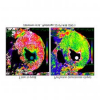Free Online Productivity Tools
i2Speak
i2Symbol
i2OCR
iTex2Img
iWeb2Print
iWeb2Shot
i2Type
iPdf2Split
iPdf2Merge
i2Bopomofo
i2Arabic
i2Style
i2Image
i2PDF
iLatex2Rtf
Sci2ools
ISBI
2004
IEEE
2004
IEEE
Phase-Correlated Dynamic CT
Phase?correlated CT is the measurement of an organ that exhibits quasi?periodic motion. Dedicated image reconstruction algorithms utilize only those data ranges that have been acquired within the desired motion phase and achieve to produce motion free image data. Dynamic CT means covering an organ of interest multiple times to monitor the concentration of contrast agents over the time. Thus information about blood flow or perfusion is obtained. Phase?correlated dynamic CT is the combination of both methods. However it requires to simultaneously measure complete organs during a duration that covers several motion cycles. Although this is far from optimal with today's CT technology we have performed dynamic CT scans of the heart with a 4?slice scanner [1]. In this paper we discuss the application and reconstruction algorithms under the assumption that true cone?beam medical CT scanners with 64 slices or more (as they have been announced for 2004) are available.
Dynamic Ct Scans | ISBI 2004 | Medical Ct Scanners | Medical Imaging | Phase Correlated Dynamic Ct |
| Added | 20 Nov 2009 |
| Updated | 20 Nov 2009 |
| Type | Conference |
| Year | 2004 |
| Where | ISBI |
| Authors | Marc Kachelriess |
Comments (0)

